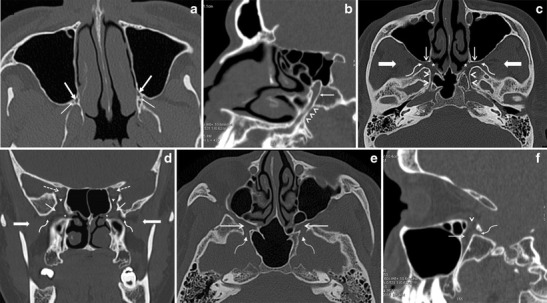Fig. 2.

a Axial HRCT image shows the greater (thick arrows) and lesser (thin arrows) palatine canals at the inferior apex of the PPF. b Oblique HRCT reconstruction through the greater palatine canal (arrowheads) shows its entire longitudinal course, from the hard palate inferiorly to the apex of the PPF superiorly (arrow). c Axial HRCT image through the PPF obtained at the level of the Vidian canal. The PPF (thin straight arrows) communicates medially with the nasal cavity via the SPF (asterisk) and laterally with the ITF (thick straight arrows) via the PMF (curved arrows). The Vidian canal (arrowheads) extends from the PPF to the foramen lacerum on each side. d Coronal HRCT image through the PPF at the level of the IOF. The PPF (thin straight arrows) communicates with the ITF (thick straight arrows) via the PMF (curved arrows). The SPF (asterisk) opens into the nasal cavity medially and the IOF (arrowheads) opens into the orbital apex (dashed arrows). e Axial HRCT image through the PPF obtained at the level of the foramen rotundum. The PPF (straight arrows) communicates with the middle cranial fossa via the foramen rotundum (curved arrow) on each side. f Sagittal HRCT reconstruction through the PPF (straight arrow) showing its communication with the orbit via the IOF (arrowhead) and with the middle cranial fossa via the foramen rotundum (curved arrow) at the same level
